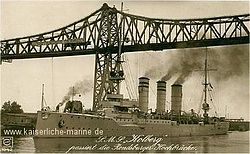Kolberg class
|
The Kolberg
|
||||||||||||||||
|
||||||||||||||||
|
||||||||||||||||
|
||||||||||||||||
|
||||||||||||||||
The Kolberg- class was a series of small cruisers of the Imperial Navy . It was designed in 1906/07 as the successor to the Dresden class . The four ships were named after German cities and put into service in 1909/10. The Kolberg class was the first class in which all ships were turbine- powered. Two ships were lost in the sea battle near Heligoland at the beginning of the war . The other two, only in use in the Baltic Sea since 1916, survived the war and were extradited in 1920. The Kolberg came to the French Navy as Colmar in the fleet service and was their flagship in the Far East.
technology
The Kolberg class was, after three ships in the previous classes, the first series with turbine propulsion only, but the four sister ships were equipped with turbines from different manufacturers. The three predecessors were all from Parsons turbines being driven, which is now only on the in the Imperial Shipyard in Kiel built Augsburg came for installation. The type ship Kolberg built near Schichau was equipped with Melms & Pfenninger turbines. The AG Vulcan in Stettin built Mainz received AEG Curtis turbines, the Cologne Germania turbines built in Kiel at the Germania shipyard .
The small cruisers of the Kolberg class were the last to have a battering bow. Compared to the previous cruiser classes, this was no longer so clearly pronounced. Otherwise, the ships had been steadily enlarged and given a stronger drive. They were 130.5 m long, constructively displaced 4,362 t and were supposed to reach 25.5 knots. In contrast to the Bremen class , they were around 20 m longer, displaced around 1,000 t more and were 3.5 knots faster.
The Kolberg's Melms & Pfenniger turbines were supposed to have 19,000 hp and reach 25.5 knots with four shafts. On her test drives she achieved 30,400 hp and the lowest speed in its class at 26.3 knots. Mainz , which was the first to enter the fleet service, had a twin-shaft AEG Curtiss turbine system that was supposed to produce 20,200 hp and 26 knots, and 22,040 hp during the test drives and at 26.8 knots, the highest speed of a German small cruiser up to that point reached. The Augsburg , which was used as the third ship after the Kolberg , had a four-shaft Parsons turbine system that was supposed to produce 19,000 hp and 25.5 knots, and with 31,033 hp during the test drives, it far exceeded the design value and reached 26.7 knots. The last unit completed in Cöln had a twin-shaft Germania turbine system that was supposed to deliver 19,000 hp and 25.5 knots, and achieved 29,036 hp and 26.8 knots in the test drives.
When arming, two further 10.5 cm L / 45 rapid loading cannons were installed on the middle upper deck for the first time, so that these cruisers had a total of twelve of them. In the course of the war , the 10.5 cm guns on the remaining cruisers, the Kolberg and the Augsburg , were exchanged for six 15 cm L / 45 rapid loading cannons.
There were some clear differences between the four sister ships. For example, For example, Augsburg had a bow ornament instead of a city coat of arms and only one headlight was installed on each of the two masts.
literature
- Hans H. Hildebrand, Albert Röhr, Hans-Otto Steinmetz: The German warships: Biographies - a mirror of naval history from 1815 to the present . Koehler, Herford
- Gerhard Koop, Klaus-Peter Schmolke: Small cruisers 1903-1918, Bremen to Cologne class . Volume 12 from ship classes and ship types of the German Navy . Bernard & Graefe, Munich 2004, ISBN 3-7637-6252-3
Web links
- Kolberg class on worldwar1.co (engl.)
- Kolberg class on historyofwar.org (Engl.)
- Kolberg -class on battleships-cruisers.co (engl.) With many pictures
Footnotes
